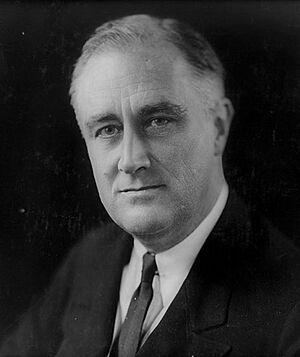Franksgiving facts for kids
In 1939, President Franklin D. Roosevelt made a big change to the Thanksgiving holiday. He moved it to the third Thursday of November. This was one week earlier than people usually celebrated it. The main idea was to help the country's economy. An earlier Thanksgiving meant more days for Christmas shopping. This change, however, caused a lot of disagreement. Many people started calling the holiday Franksgiving. This new word combined "Franklin" (for President Roosevelt) and "Thanksgiving." It was first used by Charles D. White, the mayor of Atlantic City, that same year. By late 1941, the United States Congress officially set Thanksgiving as the fourth Thursday in November. President Roosevelt signed this into law.
Why Thanksgiving Moved
A Long-Standing Tradition
The idea of Thanksgiving in the United States goes way back. George Washington was the first president to declare a Thanksgiving holiday in 1789. Later, during the Civil War in 1863, Abraham Lincoln made it a yearly tradition. He announced that Thanksgiving would be celebrated on the last Thursday of November. After Lincoln, every president followed this tradition. They all declared Thanksgiving to be on the last Thursday in November each year.
The Great Depression and Shopping
The country was going through a tough time called the Great Depression in 1939. That year, November had five Thursdays. The last Thursday fell on November 30. This meant there were only a few days left for Christmas shopping before December 25. Business leaders were worried. They thought people might not buy as many gifts, which would hurt stores.
To help businesses, President Roosevelt decided to change the date. In August 1939, he announced that Thanksgiving would be on November 23. This was a week earlier than the traditional date. A man named Fred Lazarus Jr., who led a big department store company, had asked Roosevelt to make this change. The goal was to give shoppers more time. At that time, stores usually waited until after Thanksgiving to put up Christmas decorations or start sales. This tradition was later called "Christmas creep."
A Nation Divided by Dates
The "Franksgiving" Debate
President Roosevelt's decision caused immediate arguments. Alf Landon, who had run against Roosevelt in the previous election, spoke out. He said the change showed how impulsive Roosevelt could be. Many people in New England, a region known for its strong traditions, also disagreed. James Frasier, a leader in Plymouth, Massachusetts, said he "heartily disapproved" of the change.
Impact on Sports and Schools
The sudden change in the holiday date affected many Americans' plans. For example, many college football teams played their final games on Thanksgiving Day. These games were often big rivalries. Teams had already scheduled their games for the last Thursday in November. If the date moved, stadiums might be empty. The change also caused problems for colleges and people who made calendars.
Some larger stores were happy about the extra shopping week. They hoped to make more money. However, smaller businesses worried they would lose customers to the bigger stores.
States Choose Their Own Day
A survey in late 1939 showed how people felt. Most Democrats liked the new date, but most Republicans did not. Overall, more Americans were against the change than for it.
Because of the disagreement, states had to decide for themselves. In 1939, 23 states and the District of Columbia celebrated Thanksgiving on the earlier date. But 22 states stuck to the traditional last Thursday. Three states – Colorado, Mississippi, and Texas – even celebrated Thanksgiving on both dates!
The confusion continued into 1940. That year, 32 states and the District of Columbia celebrated on the earlier date. The remaining 16 states kept the traditional date. Some people even called the traditional date the "Republican" Thanksgiving.
Thanksgiving Finds Its Permanent Home
No Big Boost for Sales
A study by the Commerce Department in 1941 looked at the impact of the change. It found that moving Thanksgiving did not really lead to a big increase in retail sales. In 1941, the situation was similar to previous years. 32 states and the District of Columbia celebrated on the earlier date, while 16 states used the traditional date.
Congress Steps In
In December 1941, the United States entered World War II. Around this time, Congress decided to act. They approved a plan that President Roosevelt signed. This plan officially made the federal Thanksgiving Day holiday the fourth Thursday in November. This new rule started in 1942. From then on, Thanksgiving would always fall between November 22 and 28.
A Fixed Date for Everyone
After Congress made this decision, most states quickly changed their laws. They wanted to match the national holiday date. The first year with five Thursdays in November after the new rule was 1944. Thanksgiving was celebrated on November 23 that year. However, a few states like Arkansas, Florida, Georgia, Idaho, Nebraska, Tennessee, Texas, and Virginia still used the old date.
After World War II ended in 1945, the new date for Thanksgiving became fully accepted across the country. Texas was the very last state to change its law. It celebrated Thanksgiving on the last Thursday for the final time in 1956. Since then, Thanksgiving has been consistently celebrated on the fourth Thursday of November.


